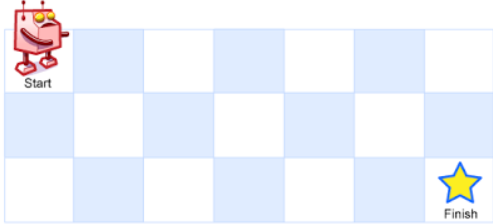Unique Paths
Problem Description
There is a robot on an m x n grid. The robot is initially located at the top-left corner (i.e., grid[0][0]). The robot tries to move to the bottom-right corner (i.e., grid[m - 1][n - 1]). The robot can only move either down or right at any point in time.
Given the two integers m and n, return the number of possible unique paths that the robot can take to reach the bottom-right corner.
The test cases are generated so that the answer will be less than or equal to 2 * 109.
Examples
Example 1:

Input: m = 3, n = 7
Output: 28
Example 2:
Input: m = 3, n = 2
Output: 3
Explanation:
From the top-left corner, there are a total of 3 ways to reach the bottom-right corner:
1. Right -> Down -> Down
2. Down -> Down -> Right
3. Down -> Right -> Down
Constraints
1 <= m, n <= 100
Solution for Unique Paths
Approach
Brute Force
- The brute force approach uses recursion to explore all possible paths from the top-left to the bottom-right corner of the grid. At each cell, the robot has two choices: move right or move down.
Recursive function:
int uniquePathsBruteForce(int m, int n) {
if (m == 1 || n == 1) {
return 1;
}
return uniquePathsBruteForce(m - 1, n) + uniquePathsBruteForce(m, n - 1);
}
Complexity:
- Time Complexity:
O(2^(m+n))- Each recursive call generates two more recursive calls, leading to an exponential number of calls. - Space Complexity:
O(m+n)- The recursion stack can go as deep as the sum ofmandn.
Corner Cases:
- If
mornis 1, there's only one path straight to the destination. - The function assumes valid input where
mandnare positive integers.
Optimized Approach
- The optimized approach uses dynamic programming to avoid redundant calculations. We create a 2D array
dpwheredp[i][j]represents the number of unique paths to reach cell(i, j).
Dynamic Programming Solution:
int uniquePaths(int m, int n) {
vector<vector<int>> dp(m, vector<int>(n, 1));
for (int i = 1; i < m; i++) {
for (int j = 1; j < n; j++) {
dp[i][j] = dp[i-1][j] + dp[i][j-1];
}
}
return dp[m-1][n-1];
}
Complexity:
- Time Complexity:
O(m*n)because We fill in each cell of them x nmatrix exactly once. - Space Complexity:
O(m*n)We use a 2D array to store the number of paths for each cell.
Further Optimization
We can further optimize the space complexity to O(n) by using a single array to keep track of the current row's path counts.
int uniquePaths(int m, int n) {
vector<int> dp(n, 1);
for (int i = 1; i < m; i++) {
for (int j = 1; j < n; j++) {
dp[j] += dp[j-1];
}
}
return dp[n-1];
}
Complexity of Optimized Approach:
- Time Complexity:
O(m*n)- Still filling in each cell exactly once. - Space Complexity:
O(n)- Using a single array of sizen.
Corner Cases:
- If either
mornis 1, the function should return 1 since there's only one path straight to the destination. - TThe function handles cases where
mornis very large efficiently within the constraints
- Solution
Implementation
function Solution(a,b) { var uniquePaths = function(m, n) { if (m === 0 || n === 0) return 0; let dp = new Array(n).fill(1); for (let i = 1; i < m; i++) { for (let j = 1; j < n; j++) { dp[j] += dp[j - 1]; } } return dp[n - 1]; }; const m = 3; const n = 7; const output = uniquePaths(m, n); return ( <div> <p> <b>Input: </b> {m,' ',n} </p> <p> <b>Output:</b> {output.toString()} </p> </div> ); }
Complexity Analysis
- Time Complexity:
- Space Complexity:
Code in Different Languages
- JavaScript
- TypeScript
- Python
- Java
- C++
var uniquePaths = function(m, n) {
if (m === 0 || n === 0) return 0;
let dp = new Array(n).fill(1);
for (let i = 1; i < m; i++) {
for (let j = 1; j < n; j++) {
dp[j] += dp[j - 1];
}
}
return dp[n - 1];
};
function uniquePaths(m: number, n: number): number {
if (m === 0 || n === 0) return 0;
let dp: number[] = new Array(n).fill(1);
for (let i = 1; i < m; i++) {
for (let j = 1; j < n; j++) {
dp[j] += dp[j - 1];
}
}
return dp[n - 1];
};
class Solution(object):
def uniquePaths(self, m, n):
if m == 0 or n == 0:
return 0
dp = [1] * n
for i in range(1, m):
for j in range(1, n):
dp[j] += dp[j - 1]
return dp[-1]
class Solution {
public int uniquePaths(int m, int n) {
if (m == 0 || n == 0) return 0;
int[] dp = new int[n];
Arrays.fill(dp, 1);
for (int i = 1; i < m; i++) {
for (int j = 1; j < n; j++) {
dp[j] += dp[j - 1];
}
}
return dp[n - 1];
}
}
class Solution {
public:
int uniquePaths(int m, int n) {
if (m == 0 || n == 0) return 0;
vector<int> dp(n, 1);
for (int i = 1; i < m; i++) {
for (int j = 1; j < n; j++) {
dp[j] += dp[j - 1];
}
}
return dp[n - 1];
}
};
References
-
LeetCode Problem: Unique Paths
-
Solution Link: LeetCode Solution